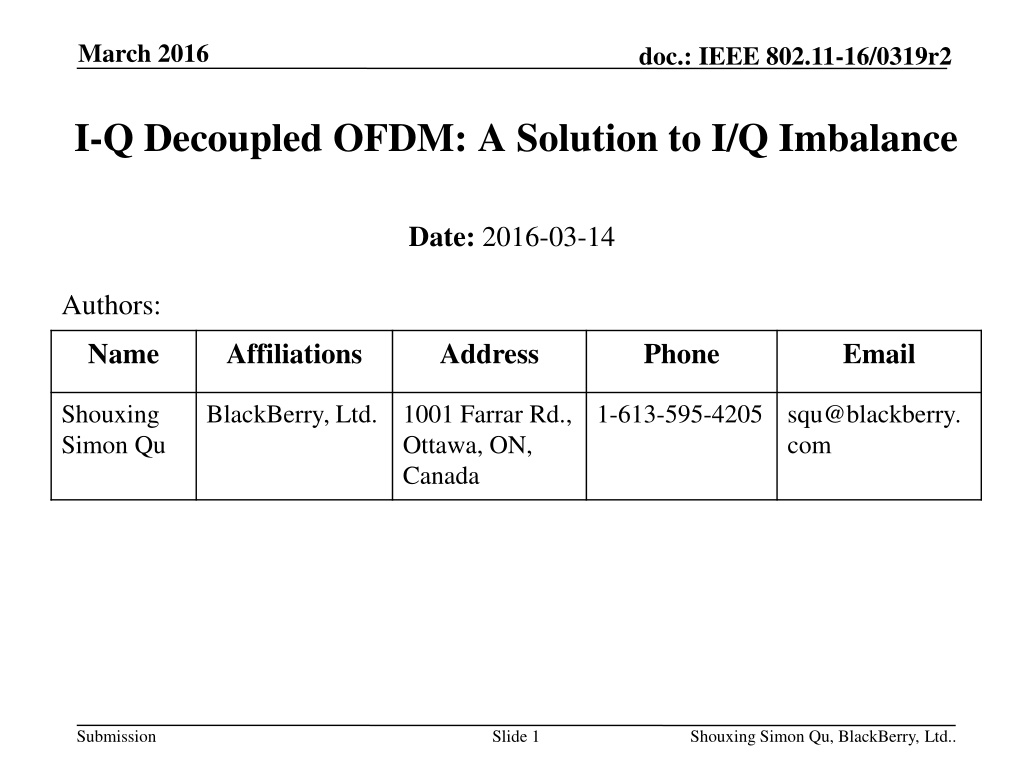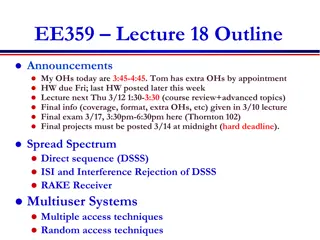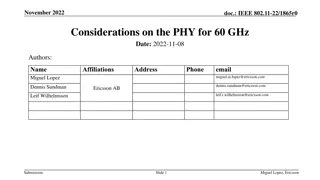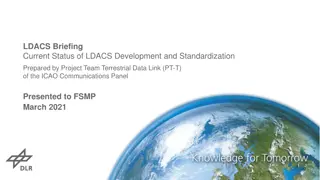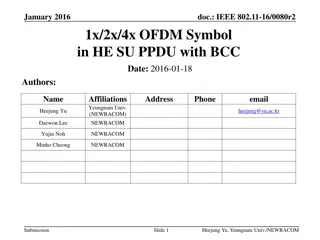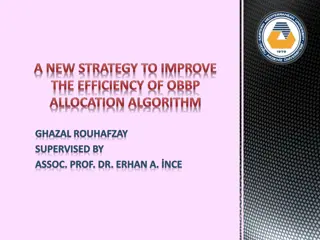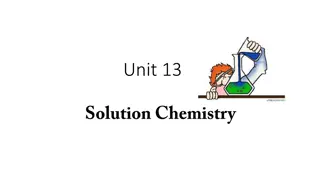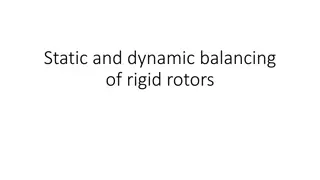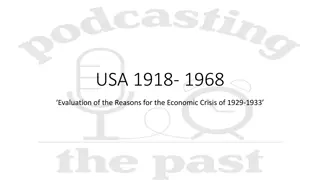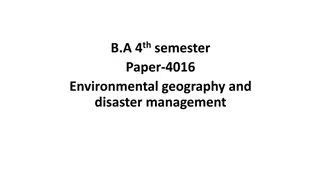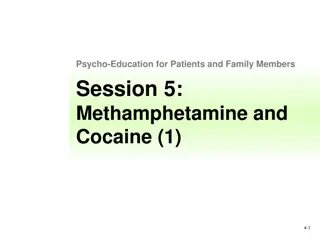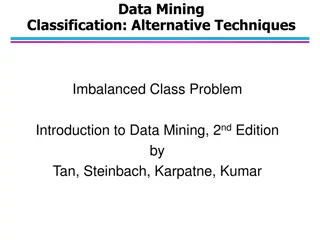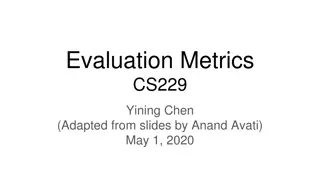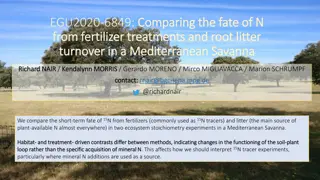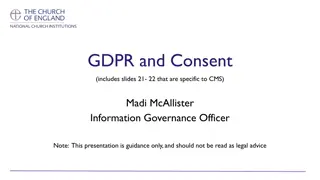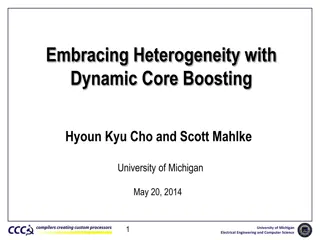Solution to I/Q Imbalance in OFDM Systems
OFDM modulation, widely used in communication systems like IEEE 802.11, suffers from I/Q Imbalance (IQI), impacting performance. This document proposes a robust solution called I-Q Decoupled OFDM (DC-OFDM), where independent data sets generate real (I) and imaginary (Q) signals, mitigating IQI effects. Details include fundamentals of OFDM, DFT/IDFT expressions, and the impact of IQI on OFDM signals.
Download Presentation

Please find below an Image/Link to download the presentation.
The content on the website is provided AS IS for your information and personal use only. It may not be sold, licensed, or shared on other websites without obtaining consent from the author. Download presentation by click this link. If you encounter any issues during the download, it is possible that the publisher has removed the file from their server.
E N D
Presentation Transcript
March 2016 doc.: IEEE 802.11-16/0319r2 I-Q Decoupled OFDM: A Solution to I/Q Imbalance Date: 2016-03-14 Authors: Name Affiliations Address Phone Email Shouxing Simon Qu BlackBerry, Ltd. 1001 Farrar Rd., Ottawa, ON, Canada 1-613-595-4205 squ@blackberry. com Submission Slide 1 Shouxing Simon Qu, BlackBerry, Ltd..
March 2016 doc.: IEEE 802.11-16/0319r2 Abstract OFDM has been adopted by various communications systems including IEEE 802.11. I-Q Imbalance (IQI) has adverse impact on OFDM performance, as pointed out in [1]-[2]. A new OFDM modulation scheme, called I-Q Decoupled OFDM (DC-OFDM), is proposed in this submission. In DC-OFDM, the real (I) and the imaginary (Q) time-domain signals are generated using independent input data sets. DC-OFDM is robust to I-Q Imbalance. Submission Slide 2 Shouxing Simon Qu, BlackBerry, Ltd.. ..
March 2016 doc.: IEEE 802.11-16/0319r2 OFDM Basics In regular OFDM, N subcarriers are independently modulated by N complex numbers. A set of N complex symbols, {??}, is transformed to a set of time- domain complex numbers, {??}, through IDFT, 1 ? ?=0 ? 1????? ?2??? IDFT: , (1) ??= ? ? 1????? ?2??? DFT: . (2) ??= ?=0 ? k & n: 0, 1, , N-1. ??: specifies the signal magnitude and phase of the k-th subcarrier at frequency ??= ? ?? Hz. Submission Slide 3 Shouxing Simon Qu, BlackBerry, Ltd.. ..
March 2016 doc.: IEEE 802.11-16/0319r2 General Expressions for DFT/IDFT with Frequency Offset 1 ? ?=0 ? 1????? ?2? ?+? ? IDFT: , (3) ?? ???? ?? = ? ? 1????? ?2?(?+?)? DFT: . (4) ?? ???{??} = ?=0 ? ? = 0 or 0.5: o ? = 0:without frequency offset,i.e. 1 (2) o ? = 0.5: with a frequency offset equal to half of subcarrier space. Submission Slide 4 Shouxing Simon Qu, BlackBerry, Ltd..
March 2016 doc.: IEEE 802.11-16/0319r2 PSD PSD k k 0 1 2 3 4 5 6 7 0 0 1 2 3 4 5 6 7 0 Subcarriers (b) N=8, = 0.5 Subcarriers (a) N=8, = 0 Fig. 1 o Sequences are cyclically periodic in discrete signal processing. Submission Slide 5 Shouxing Simon Qu, BlackBerry, Ltd..
March 2016 doc.: IEEE 802.11-16/0319r2 Impact of I-Q Imbalance on OFDM (1) Transmitted time-domain symbol: ??= ??+ ???. Due to IQI, received time-domain symbol: ??= ??+ ? ??, ??= (? + ?)??and ??= (? ?)??. . Thus, ??= ???+ ??? = conjugate of ??, is interference (in time-domain). ?? In frequency Domain, ?? ??? ?? = ???+ ??? ? 2? , :is interference to detecting ??. where, ?? ? 2? = ??? ?? Submission Slide 6 Shouxing Simon Qu, BlackBerry, Ltd..
March 2016 doc.: IEEE 802.11-16/0319r2 Impact of I-Q Imbalance on OFDM (2) ? ??= ??? ? 2? k-th tone. : Image leaking from (? ? 2?)-thtone to Image Leakage Ratio (ILR): ??? 20???10 ? ? (dB). Example 1: Assuming ??= 1.1??+ ?0.9??, then . ??= 1.0 + 0.1 ??+ ? 1.0 0.1 ??= 1.0 ??+ 0.1?? That is, ? = 1.0, ? = 0.1. ??? = 20 dB. Submission Slide 7 Shouxing Simon Qu, BlackBerry, Ltd..
March 2016 doc.: IEEE 802.11-16/0319r2 Impact of I-Q Imbalance on OFDM (3) ? ??= ??? ? 2? k-th tone. : Image leaking from (? ? 2?)-thtone to Example 2: Value of (? ? 2?) with N=8: 0 1 2 3 4 5 6 7 k 7 0 6 7 5 6 4 5 3 4 2 3 1 2 0 1 ? = 0.5 ? = 0 See Fig. 1: Tones of same color interfere each other Submission Slide 8 Shouxing Simon Qu, BlackBerry, Ltd..
March 2016 doc.: IEEE 802.11-16/0319r2 Impact of I-Q Imbalance on MU OFDM [1] RF I/Q Amplitude Imbalance: 1dB, Phase Imbalance: 5deg 10 Without Impairment With Impairment 5 Image Interference 0 -5 -10 PSD -15 -20 -25 -30 -35 -40 -10 -8 -6 -4 -2 0 2 4 6 8 10 MHz Fig. 2 [1] Rui Yang et al.: I/Q Imbalance Impact to TGax OFDMA Uplink Reception , IEEE 802.11-15/1314r1, Nov. 9, 2015. Submission Slide 9 Shouxing Simon Qu, BlackBerry, Ltd..
March 2016 doc.: IEEE 802.11-16/0319r2 OFDM Signal Robust To I-Q Imbalance Due to IQI, the interference to ??? is ??? ? 2? . Solution to IQI: intentionally set . (5) ?? ? 2?= ?? Then the interference becomes The received signal becomes ??? ? 2? =???. ??= (? +?)??. without interference. Eq.(5): The sequence of {??} is of Conjugate Symmetry in frequency domain. Submission Slide 10 Shouxing Simon Qu, BlackBerry, Ltd..
March 2016 doc.: IEEE 802.11-16/0319r2 Conjugate Symmetry in Frequency Domain Example: for N=8, For = 0.5: o ?7=?0 ,?6=?1 , ?4=?3 . ,?5=?2 o [ 1 3?,3 + 3?, 3 ?, 1 ?, 1 + ?, 3 + ?, 3 3?, 1 + 3?]. For = 0: o ?4= ?4 , ?6= ?2 , ?7= ?1 . , ?5= ?3 , ?0= ?0 o ?0 and ??/2 should be real. o [ 1,3 + 3?, 3 ?, 1 ?, 3, 1 + ?, 3 + ?,3 3?]. Submission Slide 11 Shouxing Simon Qu, BlackBerry, Ltd..
March 2016 doc.: IEEE 802.11-16/0319r2 Frequency Conjugate Symmetry for = 0.5 Fig. 3 Submission Slide 12 Shouxing Simon Qu, BlackBerry, Ltd..
March 2016 doc.: IEEE 802.11-16/0319r2 Frequency Conjugate Symmetry for = 0 Fig. 4 Submission Slide 13 Shouxing Simon Qu, BlackBerry, Ltd..
March 2016 Power Spectrum with Conjugate Symmetry doc.: IEEE 802.11-16/0319r2 Fig. 5 Submission Slide 14 Shouxing Simon Qu, BlackBerry, Ltd..
March 2016 doc.: IEEE 802.11-16/0319r2 I-Q Decoupled OFDM Signal (1) The OFDM signals with (frequency) conjugate symmetry are robust to IQI. Problem: with N subcarriers, it only carries information of N/2 complex numbers. Compared to regular OFDM, data rate is reduced by half. Submission Slide 15 Shouxing Simon Qu, BlackBerry, Ltd..
March 2016 doc.: IEEE 802.11-16/0319r2 I-Q Decoupled OFDM Signal (2) Property of Fourier Transform: A signal being conjugate symmetrical in frequency domain is a real signal in time domain. Solution: Generate two independent real OFDM signals, combined into a complex signal, carrying information of N complex numbers with N subcarriers. Submission Slide 16 Shouxing Simon Qu, BlackBerry, Ltd..
March 2016 doc.: IEEE 802.11-16/0319r2 I-Q Decoupled OFDM Signal (2) Fig. 6 B1 and B2 can be any box in Fig.3 and Fig. 4. Submission Slide 17 Shouxing Simon Qu, BlackBerry, Ltd..
March 2016 doc.: IEEE 802.11-16/0319r2 Generation of DC-OFDM Signal with Precoding Fig. 7 (( = 0.5) When B0 is bypassed, it becomes a regular OFDM generator. Submission Slide 18 Shouxing Simon Qu, BlackBerry, Ltd..
March 2016 doc.: IEEE 802.11-16/0319r2 DC-OFDM for MU Applications DC-OFDM can be used for single user or multi-user (MU) applications. For MU applications: For each pair of symmetric tones, The two tones of each symmetric pair are allocated to a same user; Two tones of each symmetric pair are modulated by a data symbol and its conjugate respectively. Submission Slide 19 Shouxing Simon Qu, BlackBerry, Ltd..
March 2016 doc.: IEEE 802.11-16/0319r2 Example: Four Users, N=8, = 0.5 Fig. 8 Submission Slide 20 Shouxing Simon Qu, BlackBerry, Ltd..
March 2016 doc.: IEEE 802.11-16/0319r2 Simulation Results: I-Q Imbalance Impact Fig. 9 Submission Slide 21 Shouxing Simon Qu, BlackBerry, Ltd..
March 2016 doc.: IEEE 802.11-16/0319r2 Conclusions IQI has adverse impact on regular OFDM systems. Real OFDM (time-domain) signal is robust to IQI. Real time-domain = Conjugate-symmetric in frequency domain. DC-OFDM signal: o A complex OFDM signal formed by two independently generated real time-domain OFDM signals. o Robust to IQI. o Same data rate as regular OFDM. o Providing frequency diversity gain. o SU & MU. Submission Slide 22 Shouxing Simon Qu, BlackBerry, Ltd.. .
March 2016 doc.: IEEE 802.11-16/0319r2 References [1] Rui Yang et al., I/Q Imbalance Impact to TGax OFDMA Uplink Reception , IEEE 802.11-15/1314r1, Nov. 9, 2015. [2] Marcus Windisch, and Gerhard Fettweis, On the impact of I/Q imbalance in multi-carrier systems for different channel scenarios , IEEE International Symposium on Circuits and Systems 2007 (ISCAS2007), New Orleans, LA, USA, May 27-30, 2007. Submission Slide 23 Shouxing (Simon) Qu, Blackberry, Ltd.
March 2016 doc.: IEEE 802.11-16/0319r2 Straw Poll 1) Do you agree that I-Q decoupled OFDM is more robust to I-Q imbalance than the regular OFDM ? 2) Would you consider adding I-Q decoupled OFDM, or a modified version of this proposal, in a future version of 802.11ax draft ? Submission Slide 24 Shouxing (Simon) Qu, Blackberry, Ltd.
